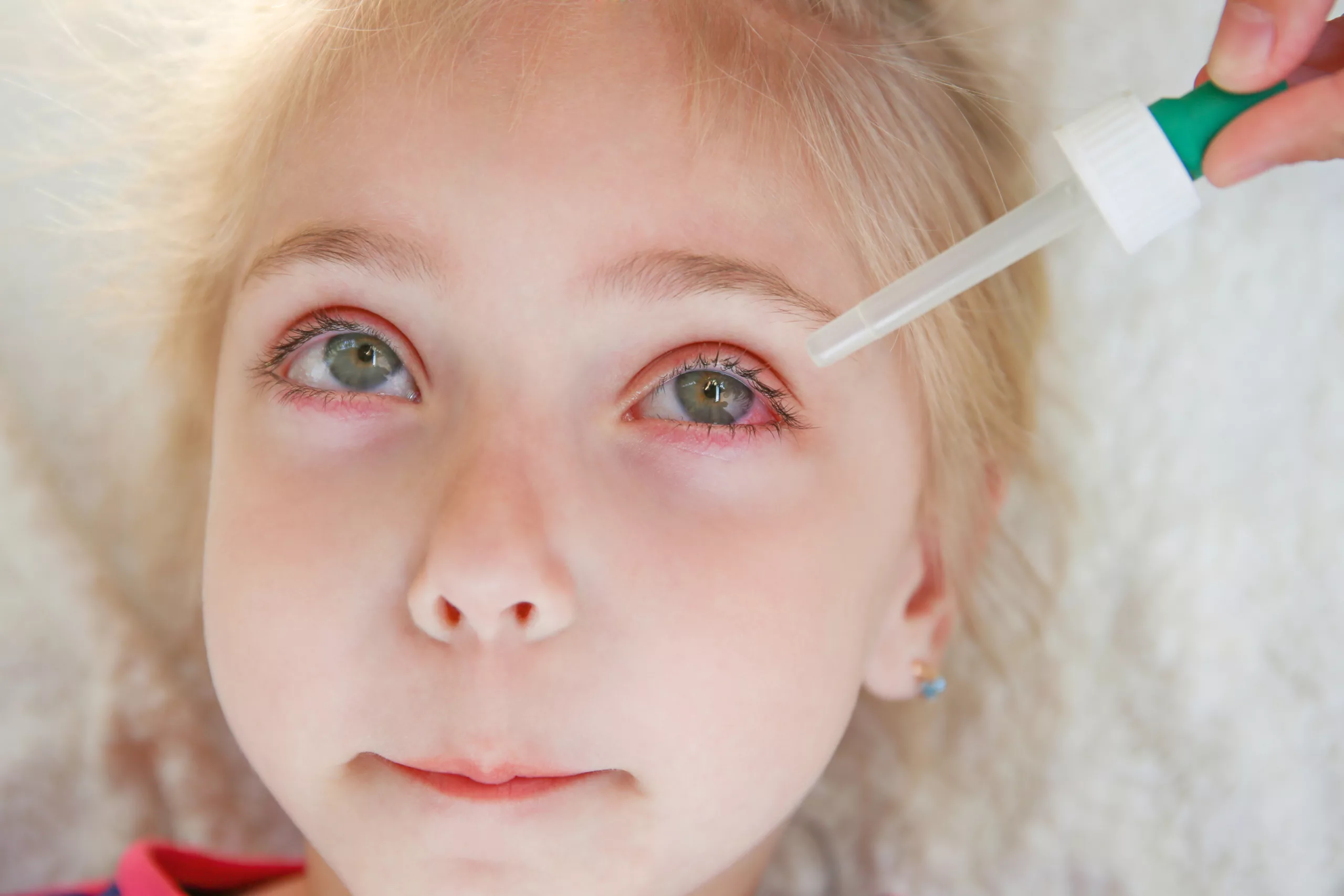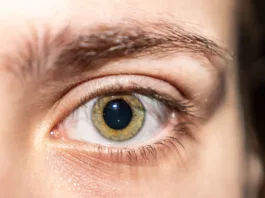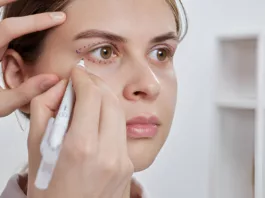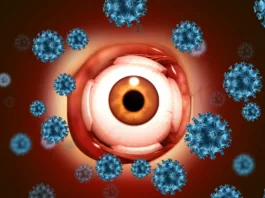Allergic conjunctivitis is the immediate or delayed inflammation of the conjunctiva in response to specific allergens, such as animal danders, dust, pollen, mold spores, or others. The conjunctiva is the membrane covering the eyeball’s white portion and lining the eyelids’ inner side. This is usually an acute condition; it is rarely chronic.
Exposure to different allergens may cause itching, redness, irritation, and swelling of the conjunctiva. A 2021 US survey reported that most individuals with allergic reactions presented with symptoms of eye allergies like tearing and itching.1 Elflein, J. (2021, May 10). Common allergic reactions among adults with allergies U.S. 2021. Statista. Retrieved August 22, 2023, from https://www.statista.com/statistics/1243240/common-allergic-reactions-us/
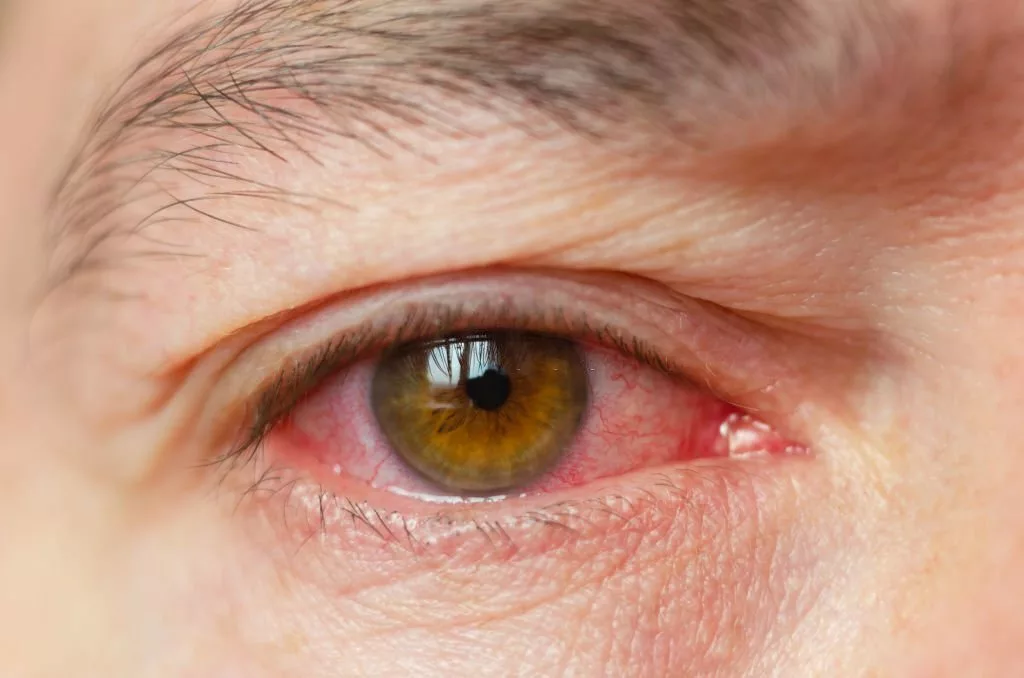
Allergic Conjunctivitis Causes
The allergic conjuctivtis results from a hypersensitivity reaction to various outdoor and indoor allergens entering the eye.2 Allergic conjunctivitis: MedlinePlus medical encyclopedia. (n.d.). MedlinePlus – Health Information from the National Library of Medicine. Retrieved August 23, 2023, from https://medlineplus.gov/ency/article/001031.htm Your body produces histamine to combat foreign agents, producing an allergic reaction.
Common allergens triggering histamine release are:
- Chemical scents like perfumes, detergents, or shampoo.
- Pollens from grass, trees and ragweed.
- Dust mites
- Pet danders
- Mold spores
- Smoke and fumes
- Cosmetics and eye makeup products
- Eye drops or contact lens solution
Pathophysiology of Allergic Conjunctivitis
When an allergen comes in contact with the eye surface, it triggers an IgE antibody-mediated hypersensitivity reaction.3 Baab, S., & Le, P. H. (2022, May 23). Allergic Conjunctivitis – StatPearls – NCBI bookshelf. National Center for Biotechnology Information. Retrieved August 19, 2023, from https://www.ncbi.nlm.nih.gov/books/NBK448118/ This response results in the degranulation of mast cells and the release of inflammatory mediators like histamine, leukotrienes, and prostaglandins in blood circulation. These chemical substances modulate immediate and delayed allergic reaction phases in susceptible individuals.
Allergic Conjunctivitis Symptoms
Symptoms of allergic conjunctivitis appear rapidly as soon as the eye encounters an allergen. Alternatively, allergic symptoms due to eye drops or contact lens solution may occur after a few days.
Most people show the following signs of allergy in both eyes.4 Syed, Z. A. (2023, April 3). Allergic conjunctivitis – Eye disorders – Merck Manuals Consumer Version. Merck Manuals Consumer Version. Retrieved August 19, 2023, from https://www.merckmanuals.com/home/eye-disorders/conjunctival-and-scleral-disororders/allergic-conjunctivitis
- Pink eyes: Inflammation of the eyes due to expansion of capillaries in the conjunctiva causes redness (Hyperemia) or a pink appearance.
- Itching: The most common symptom of allergic conjunctivitis is eye irritation, which causes intense itchiness. Rubbing your eyes worsens the itching.
- Watery Eyes: Histamine releases from mast cells and dilation of blood vessels irritates the nerve endings, resulting in increased tear secretion.
- Soreness and Burning: Inflammation of the conjunctiva makes the surrounding area soft and sore. Some people also experience a burning feeling with soreness.
- Puffy eyelids: Eyelids become swollen due to inflammation, and rubbing worsens it.
- Painful Eyes: Although not very common, a person may feel pain in one or both eyes.
- Photosensitivity: Sometimes, a person becomes sensitive to light and faces problems with vision.
- Sneezing: Allergy symptoms, including a runny nose, itchy nose, sneezing, or a scratchy throat, may be present with allergic conjunctivitis.
Types of Allergic Conjunctivitis
Based on causes and varying symptoms, here are the three common types of allergic conjunctivitis:
Acute Allergic Conjunctivitis
It is a sudden, immediate allergic response of the eye in sensitized people. Whenever they come into contact with allergens like animal fur, grass, or pollen, they present with itching, redness, and swelling of the conjunctiva. Acute allergic conjunctivitis is usually self-limiting and resolves with home care or anti-allergic eye drops.
Seasonal Allergic Conjunctivitis (SAC)
SAC occurs when an air-borne seasonal allergen, usually a grass pollen in summer, lands on the eye surface. It starts an allergic reaction, resulting in watery eyes, itching, swelling, and redness. Also, affected individuals usually show throat, nose, and sinus symptoms, such as runny nose, sneezing, etc. Anti-histamine eye drops and tablets can manage SAC well.
Perennial Allergic Conjunctivitis (PAC)
PAC is a less common condition that occurs year-round. Allergens like indoor or outdoor dust mites and animal dander can affect the sensitized person throughout the year. The symptoms and management are similar to SAC.
Risk Factors for Allergic Conjunctivitis
People with other allergies are at greater risk of allergic conjunctivitis. Living in dry and windy areas with higher pollen counts or other allergens can also make one susceptible to developing eye allergies.
Some common risk factors5 Adamopoulou, C., Bunya, V. Y., & Grigorian, A. P. (2023, March 1). Allergic conjunctivitis. EyeWiki. Retrieved August 24, 2023, from https://eyewiki.aao.org/Allergic_Conjunctivitis#Risk_Factors for allergic conjunctivitis are:
- Positive family history of allergies like eczema or seasonal allergies.
- Genetic predisposition with other conditions like asthma and dermatitis.
- Indoor allergens like dust mites, mold spores, or animal dander.
- Environmental allergens occur with changing seasons or throughout the year.
- Increased pollen count, usually during springtime.
- Dry, hot, and windy environment.
- Wearing soft contact lenses and poor hygiene for long periods.
- Allergy to contact lens solution.
How to Diagnose Allergic Conjunctivitis?
Healthcare providers usually recognize allergic conjunctivitis by evaluating the symptoms and typical eye appearance. Diagnostic tests are not commonly needed for mild conditions. However, the doctor may try the following options to find the exact cause of illness in severe cases.6Dupuis, P., & Prokopich, C. L. (2020, January 21). A contemporary look at allergic conjunctivitis. BioMed Central. Retrieved August 25, 2023, from https://aacijournal.biomedcentral.com/articles/10.1186/s13223-020-0403-9
- Eye Examination: The physician examines the patient’s face, eyelids, and conjunctiva in a well-lit room. Slit-lamp biomicroscopy of eye tissues with an assessment of the cornea is highly recommended.
- Skin Prick Testing: Doctors can test the skin for specific allergens using scratch tests or intradermal injections of the allergen. In-vitro tests for IgE antibodies to particular allergens are used to diagnose allergies.
- Conjunctival Scraping: Ophthalmologists obtain conjunctival scrapings to look for the causative agent and diagnose various types of conjunctivitis.
- Blood Test: It shows antibodies circulating in your blood against a specific allergen
Allergic Conjunctivitis Treatment
The primary measure for all types of allergic conjunctivitis is the avoidance of specific allergens. Adequate patient education can help prevent the symptoms from getting worse. In addition, several home care measures and anti-allergic medications can also help relieve symptoms.7Rosa, M. L., & Lionetti, E. (2013, March 14). Allergic conjunctivitis: A comprehensive review of the literature. PubMed Central (PMC). Retrieved August 21, 2023, from https://www.ncbi.nlm.nih.gov/pmc/articles/PMC3640929
Home Care
Supportive measures for improving symptoms of allergic conjunctivitis at home may include:
- Avoid rubbing your eyes.
- Rinse the affected eye with water or an artificial tear solution to remove the allergen.
- Use a cold compress or ice packs on the eye to relieve inflammation.
- Take a bath before going to bed to remove any allergens.
- Change and wash clothes frequently.
- Avoid eye makeup products like mascara and eyeliner.
- Avoid contact lenses until the symptoms get better.
Medication Therapy
The doctor may prescribe the following classes of topical and systemic medications to manage allergic conjunctivitis.
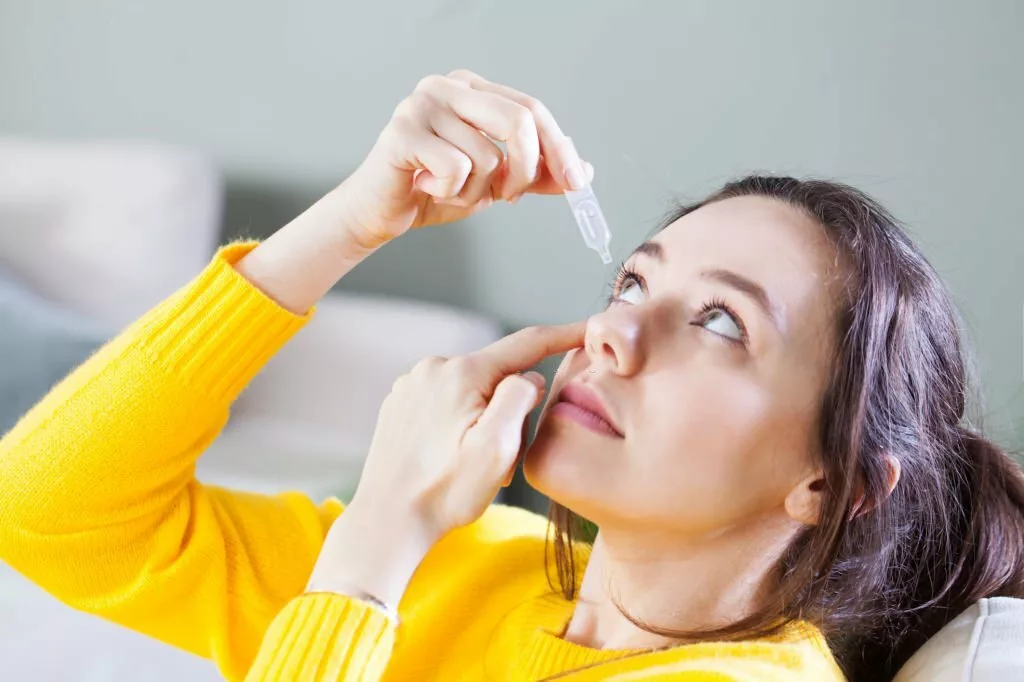
Over-the-counter (OTC) Topical Antihistamines
Using OTC antihistamine eye drops or a combination of antihistamines and vasoconstrictor agents for a short duration can treat acute allergic conjunctivitis.
- OTC vasoconstrictors include oxymetazoline HCl, naphazoline HCl 0.05%, antazoline 0.5%, or phenylephrine 0.12%.
- Second-generation antihistamines in eye drops include pheniramine maleate 0.3%, emedastine, and levocabastine HCl 0.05%.
Mast Cell Stabilizers
Topical mast cell stabilizers like sodium cromoglicate 2% or lodoxamide 0.1% drops can be used for recurrent allergic conjunctivitis. However, a combination of topical antihistamines and a mast cell stabilizer, such as olopatadine and ketotifen, is more effective for seasonal and perennial allergies.
Steroid Eye Drops
If symptoms are not controlled with other options, a short course (less than two weeks) of corticosteroid eye drops is effective. However, it requires a careful consultation with a specialist before use and a follow-up for further advice.
NSAIDs
For pain relief, you can use topical nonsteroidal anti-inflammatory eye drops, such as Ketorolac tromethamine 0.5%, along with other anti-allergic eye drops.
Systemic Anti-histamines
Oral antihistamines like cetirizine, levocetirizine, fexofenadine, or loratadine can be used once daily as an adjunct to topical therapy to relieve systemic symptoms such as allergic rhinitis.
Allergen Immunotherapy
Immunotherapy for specific allergens is beneficial and cost-effective for people with persistent allergic conjunctivitis. It is a long-term treatment that decreases sensitivity to allergens and reduces allergic symptoms.8Norris, M. R. (2020, December 20). Use of allergen immunotherapy for treatment of allergic conjunctivitis. Retrieved 26 August, 2023 from PubMed. https://pubmed.ncbi.nlm.nih.gov/33044339/
A particular allergen is injected periodically in increasing doses, hence developing tolerance to that allergen. Allergy shots provide long-lasting relief from symptoms and prevent new allergies.
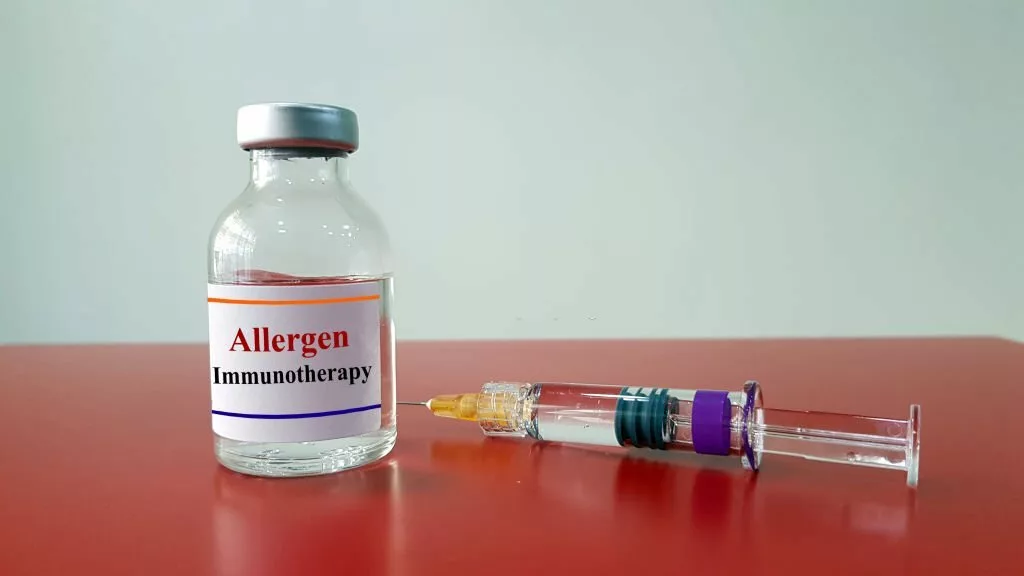
Complications of Allergic Conjunctivitis
Typically, allergic conjunctivitis is not a serious threat and rarely results in complications. However, it may result in severe consequences in some cases.
- Some patients may present with severe outcomes such as eye scarring.
- The disease may develop into an infection spreading to other body parts and causes various secondary infections.
- Prolonged use of topical steroids for allergic conjunctivitis can cause visual changes and cataracts.
Prognosis
The prognosis of allergic conjunctivitis is good in most patients. Allergic symptoms usually disappear with treatment. However, they can last longer if you continuously get exposed to allergens. Also, long-term use of some medications may lead to vision problems or cataracts.
When to See an Ophthalmologist?
Allergic conjunctivitis usually responds well to self-care measures and over-the-counter therapies. However, you must contact your medical professional if you face any of the following problems:
- Swollen and puffy eyelids
- Eye pain is getting severe.
- Problems with vision due to allergic conjunctivitis.
- Symptoms are not responding to home care and over-the-counter treatments.
- Headache, along with other symptoms of allergic reactions.
- For thorough eye examination before using steroid eye drops for severe recurrent allergies.
How to Prevent Allergic Conjunctivitis?
Simple lifestyle changes can help prevent conjunctivitis. You can practice the following self-care tips to avoid eye allergies:
- Install a humidifier or air purifier in the home.
- Use lubricating eye drops or artificial tears.
- Wear sunglasses when going into sunlight.
- Apply ice packs or cold compress to relieve eye irritation.
- Use an overnight HEPA filter to avoid allergens in the bedroom.
Is Conjunctivitis Contagious?
Allergic conjunctivitis is not contagious. However, infectious conjunctivitis, caused by viruses or bacteria, is highly contagious.9Syed, Z. A. (2023, April 3). Infectious conjunctivitis – Eye disorders – Merck Manuals Consumer Version. Merck Manuals Consumer Version. Retrieved August 22, 2023, from https://www.merckmanuals.com/home/eye-disorders/conjunctival-and-scleral-disorders/infectious-conjunctivitis They can be transmitted through personal contact, coughing, sneezing, and touching contaminated surfaces.
Differential Diagnosis
It’s important to differentiate allergic conjunctivitis from bacterial, viral, other severe allergic and infectious eye conditions. Bacterial and viral conjunctivitis are highly contagious due to their causative agents, spreading via direct or indirect exposure to discharge from the eye. Both conditions can occur with upper respiratory infections or common cold.
Bacterial Conjunctivitis
Bacterial Conjunctivitis is an eye infection more common in kids caused by bacteria such as Streptococcus pneumoniae, Staphylococcus aureus, Moraxella catarrhalis, or Haemophilus influenzae. Some other bacterial species, like Neisseria gonorrhoeae or Chlamydia trachomatis, can less frequently cause conjunctivitis. Contact lenses that are not properly cleaned or contaminated can also cause bacterial infection.
Patients usually present with sticky eyelids and viscous discharge (pus) from one or both eyes, commonly in the morning. Mild cases resolve without any specific treatment within 2 to 5 days. However, doctors may prescribe antibiotic eye drops and ointment to reduce complications and spread.
Viral Conjunctivitis
Viral conjunctivitis usually occurs due to adenovirus and sometimes due to Varicella zoster and herpes simplex virus. Unlike bacterial conjunctivitis, viral infection is characterized by watery discharge from one or both eyes. Most cases clear up in one or two weeks; severe cases may require antiviral medications.
Neonatal Conjunctivitis
Conjunctivitis in newborns is a severe condition due to a blocked tear duct, an infection passed from the mother, or irritation from topical antimicrobial agents.10Pink eye (Conjunctivitis) in newborns | CDC. (2022, May 19). Centers for Disease Control and Prevention. Retrieved August 19, 2023, from https://www.cdc.gov/conjunctivitis/newborns.html Infectious forms of neonatal conjunctivitis can be dangerous. However, the exact cause is usually difficult to find as symptoms are similar in most cases.
Neonates develop red, puffy eyelids with drainage a few days after birth. Some cases resolve without any treatment within 1 to 2 days. Also, healthcare providers often instill eye ointment or drops in the baby’s eyes within a few hours of birth to prevent conjunctivitis.
Dry Eyes
Allergic conjunctivitis primarily affects the conjunctiva, while dry eye mainly targets the cornea. In dry eye, corneal involvement is characterized by the uptake of vital dyes, a test that can be easily performed by an ophthalmologist. This differentiation is crucial for proper diagnosis and treatment.
Severe Allergic Ocular Conditions
More severe disorders that have an allergic eitiology include vernal conjunctivitis, GPC, and AKC:
Vernal Keratoconjunctivitis (VKC)
It is the most dangerous form of ocular allergy affecting young people, commonly males, usually in hot areas. Severe symptoms, including itching and photophobia, appear on exposure to nonspecific triggers such as wind, sunlight, or dust. The most common sign is the cobblestoning on the upper conjunctival surface.11 Rosa, M. L., & Lionetti, E. (2013, March 14). Allergic conjunctivitis: A comprehensive review of the literature. PubMed Central (PMC). Retrieved August 21, 2023, from https://www.ncbi.nlm.nih.gov/pmc/articles/PMC3640929
Atopic Keratoconjunctivitis (AKC)
Adults with a history of atopic dermatitis (AD) may develop a rare chronic, allergic eye condition, atopic keratoconjunctivitis (AKC). If not adequately treated, AKC can cause severe damage to the eye surface, resulting in corneal scarring and vision loss.
Giant Papillary Conjunctivitis (GPC)
Final Thought
Allergic conjunctivitis is an underrated condition, but it can significantly impair an individual’s health-related quality of life. Avoiding allergen exposure and maintaining adequate eye hygiene is the key to prevention. Various home care and medication therapy options are available, but the treatment choice may vary for each patient. Healthcare providers can contribute significantly to educating patients, managing symptoms, and enhancing patients’ overall quality of life.
Refrences
- 1Elflein, J. (2021, May 10). Common allergic reactions among adults with allergies U.S. 2021. Statista. Retrieved August 22, 2023, from https://www.statista.com/statistics/1243240/common-allergic-reactions-us/
- 2Allergic conjunctivitis: MedlinePlus medical encyclopedia. (n.d.). MedlinePlus – Health Information from the National Library of Medicine. Retrieved August 23, 2023, from https://medlineplus.gov/ency/article/001031.htm
- 3Baab, S., & Le, P. H. (2022, May 23). Allergic Conjunctivitis – StatPearls – NCBI bookshelf. National Center for Biotechnology Information. Retrieved August 19, 2023, from https://www.ncbi.nlm.nih.gov/books/NBK448118/
- 4Syed, Z. A. (2023, April 3). Allergic conjunctivitis – Eye disorders – Merck Manuals Consumer Version. Merck Manuals Consumer Version. Retrieved August 19, 2023, from https://www.merckmanuals.com/home/eye-disorders/conjunctival-and-scleral-disororders/allergic-conjunctivitis
- 5Adamopoulou, C., Bunya, V. Y., & Grigorian, A. P. (2023, March 1). Allergic conjunctivitis. EyeWiki. Retrieved August 24, 2023, from https://eyewiki.aao.org/Allergic_Conjunctivitis#Risk_Factors
- 6Dupuis, P., & Prokopich, C. L. (2020, January 21). A contemporary look at allergic conjunctivitis. BioMed Central. Retrieved August 25, 2023, from https://aacijournal.biomedcentral.com/articles/10.1186/s13223-020-0403-9
- 7Rosa, M. L., & Lionetti, E. (2013, March 14). Allergic conjunctivitis: A comprehensive review of the literature. PubMed Central (PMC). Retrieved August 21, 2023, from https://www.ncbi.nlm.nih.gov/pmc/articles/PMC3640929
- 8Norris, M. R. (2020, December 20). Use of allergen immunotherapy for treatment of allergic conjunctivitis. Retrieved 26 August, 2023 from PubMed. https://pubmed.ncbi.nlm.nih.gov/33044339/
- 9Syed, Z. A. (2023, April 3). Infectious conjunctivitis – Eye disorders – Merck Manuals Consumer Version. Merck Manuals Consumer Version. Retrieved August 22, 2023, from https://www.merckmanuals.com/home/eye-disorders/conjunctival-and-scleral-disorders/infectious-conjunctivitis
- 10Pink eye (Conjunctivitis) in newborns | CDC. (2022, May 19). Centers for Disease Control and Prevention. Retrieved August 19, 2023, from https://www.cdc.gov/conjunctivitis/newborns.html
- 11Rosa, M. L., & Lionetti, E. (2013, March 14). Allergic conjunctivitis: A comprehensive review of the literature. PubMed Central (PMC). Retrieved August 21, 2023, from https://www.ncbi.nlm.nih.gov/pmc/articles/PMC3640929
- 12UpToDate. (n.d.). Allergic conjunctivitis: Clinical manifestations and diagnosis. Retrieved June 15, 2024, from https://www.uptodate.com/contents/allergic-conjunctivitis-clinical-manifestations-and-diagnosis?search=allergic%20conjunctivitis&source=search_result&selectedTitle=3%7E150&usage_type=default&display_rank=2

